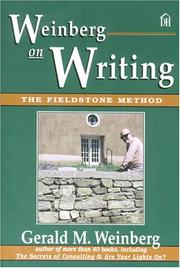Weinberg on Writing
This is one of my favorite books on writing.
The Fieldstone Method defined
Writing is like building a fieldstone wall. Instead of searching for a perfect stone, go into the field and gather a bunch of stones, and then put them into the piles.
Now you have plenty of stones to pick from, you will not be blocked by the lack of ideas. The fieldstone wall is like a writing project, and stones are like ideas.
Gather a bunch of notes, sort them into different topics, subject, categories, and put them into your writing projects.
The 5-second rule
Before you embark into the fields, you need to be able to capture notes(stones) as fast as possible, that means in 5 seconds or less. It doesn’t matter what you use for capturing the note. You can use index cards, notebook or a note-taking app on your smartphone. Use whatever you like as long as you can do it quickly.
These notes are not meant to be kept for long. So, don’t waste time writing it out perfectly. Sönke Ahrens, in his book How to take smart notes, calls these notes fleeting notes. These are not meant to be kept, but thrown away after you have processing.
You go through your day, always prepared to write down ideas, stories, experiences, that you encounter or read about. If you stumble upon a great quote, capture it; if your friend tells you a funny story, make note of it.
Sort your notes into piles
Later in the day, you go through all the stones (notes) you gathered, and decide — which ones to keep, and which ones to throw away. Now you have to find a pile for the ones you kept.
The easiest way to find a pile is to think: into which writing project this idea fits best, or where could I use this idea? You open the project and stick the idea into that, rewriting and elaborating on it. Add some details, sources, related ideas. Otherwise, weeks later, you will have no idea what the note is about. You need some context and original source.
Incubating writing projects
If the stone doesn’t fit into any of the projects you are working on, create a new project, document and stick it into that. A new writing will start to incubate, and soon you will be adding new notes into that one.
Now, multiple writing projects are growing at the same time. When it’s time to sit down and write, you don’t have to stare at the blank page anymore because the project is filled with ideas, sentences, quotes etc. If you don’t feel like writing about subject one, you will switch to subject two.
Writing and organizing
You still have to sit down and write. But you are not blocked anymore. If you are stuck on one project, you will work on another one.
There are times when you don’t feel like writing. Then you will work on organizing your projects instead. Organizing is important. The ideas, fieldstones, you have gathered might not be in the best order. Also, the ideas might not be in the best shape. They need to be fleshed out, updated, modified. Search for the refences. Work on them. That way you are always making progress with your projects even when you are not writing.
Summary
- Capture the ideas quickly.
- Sort the ideas into a corresponding pile.
- Work on multiple writing projects simultaneously
- If you can’t write, organize.
This book has so much more to offer, and I’m not doing it justice with this short article. If you are interested in learning more, go check out the book.
